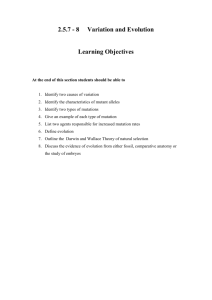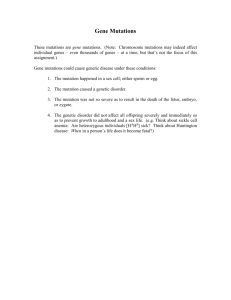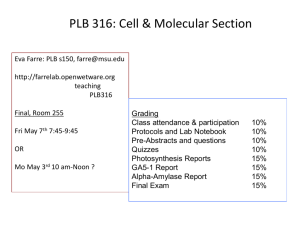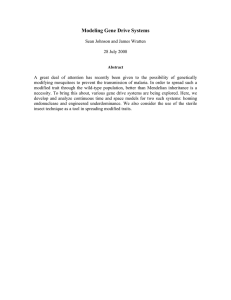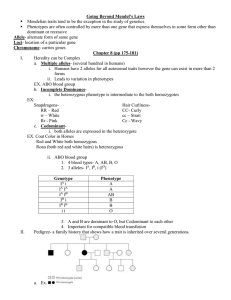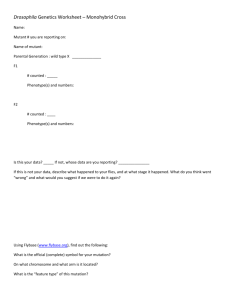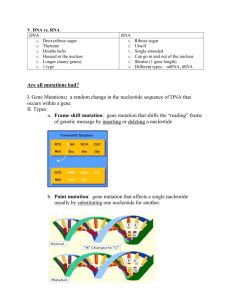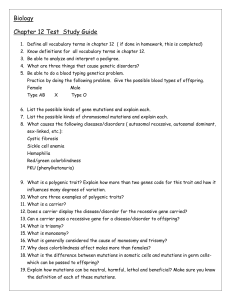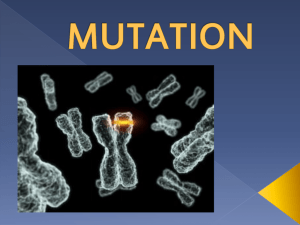7.03 Problem Set 1 Solutions 1. a.
advertisement
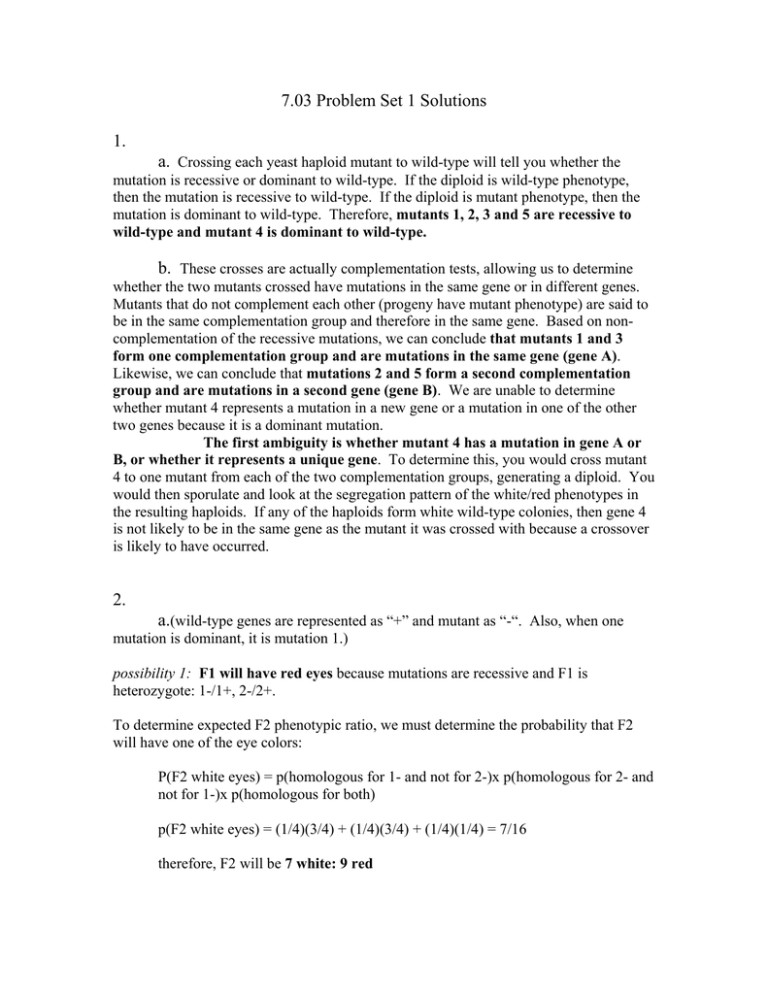
7.03 Problem Set 1 Solutions 1. a. Crossing each yeast haploid mutant to wild-type will tell you whether the mutation is recessive or dominant to wild-type. If the diploid is wild-type phenotype, then the mutation is recessive to wild-type. If the diploid is mutant phenotype, then the mutation is dominant to wild-type. Therefore, mutants 1, 2, 3 and 5 are recessive to wild-type and mutant 4 is dominant to wild-type. b. These crosses are actually complementation tests, allowing us to determine whether the two mutants crossed have mutations in the same gene or in different genes. Mutants that do not complement each other (progeny have mutant phenotype) are said to be in the same complementation group and therefore in the same gene. Based on noncomplementation of the recessive mutations, we can conclude that mutants 1 and 3 form one complementation group and are mutations in the same gene (gene A). Likewise, we can conclude that mutations 2 and 5 form a second complementation group and are mutations in a second gene (gene B). We are unable to determine whether mutant 4 represents a mutation in a new gene or a mutation in one of the other two genes because it is a dominant mutation. The first ambiguity is whether mutant 4 has a mutation in gene A or B, or whether it represents a unique gene. To determine this, you would cross mutant 4 to one mutant from each of the two complementation groups, generating a diploid. You would then sporulate and look at the segregation pattern of the white/red phenotypes in the resulting haploids. If any of the haploids form white wild-type colonies, then gene 4 is not likely to be in the same gene as the mutant it was crossed with because a crossover is likely to have occurred. 2. a.(wild-type genes are represented as “+” and mutant as “-“. Also, when one mutation is dominant, it is mutation 1.) possibility 1: F1 will have red eyes because mutations are recessive and F1 is heterozygote: 1-/1+, 2-/2+. To determine expected F2 phenotypic ratio, we must determine the probability that F2 will have one of the eye colors: P(F2 white eyes) = p(homologous for 1- and not for 2-)x p(homologous for 2- and not for 1-)x p(homologous for both) p(F2 white eyes) = (1/4)(3/4) + (1/4)(3/4) + (1/4)(1/4) = 7/16 therefore, F2 will be 7 white: 9 red possibility2: F1 will have white eyes because there is a dominant mutation in series. Even though only one of the mutant phenotypes will be expressed in the F1 heterozygote, the F1s will have white eyes because both wild-type gene products are required to make red color. p(F2 red eyes) = p(homologous for 1+ and (homologous or heterozygous for 2+)) p(F2 red eyes) = (1/4)(1/4 + 1/2) = 3/16 therefore, F2 will be 13 white: 3 red possibility 3: F1 will have white eyes because heterozygous for two dominant mutations in series. p(F2 red eyes) = p(homologous for 1+ and homologous for 2+) =(1/4)(1/4) = 1/16 therefore, F2 will be 15 white: 1 red possibility 4: F1 will have red eyes because F1 is heterozygous for recessive mutations p(F2 white eyes) = p(homozygous for 1- and homozygous for 2-) = (1/4)(1/4) = 1/16 therefore, F2 will be 1 white:15 red possibility 5: F1 will have red eyes because even though there is a dominant mutation, it is in parallel, so can be compensated for by the wild-type allele of the other gene. p(F2 white eyes = p(homologous for 2- (and homologous or heterozygous for 1-)) = (1/4)(1/2 + 1/4) = 3/16 therefore, F2 will be 3 white: 13 red possibility 6: F1 will have white eyes because both mutations are dominant in parallel. p(F2 white eyes) = p((heterozygous or homozygous for 1-) and (heterozygous or homozygous for 2-)) =(1/2 + 1/4)(1/2 + 1/4) = 9/16 therefore, F2 will be 9 white: 7 red b. to determine which of the possibilities is consistent with the observed data, we must do a chi-squared test using the expected ratios found in part (a). The df = 1. we can reject hypothesis if p<0.05 χ2 =Σ [(O-E)2]/E possibility 1: expected ratio is 7 white: 9 red, so out of 24 total F2’s we would expect 10.5 white and 13.5 red. χ2= (5-10.5) 2/10.5 + (19-13.5) 2/13.5 = 5.12 by using the provided table and df=1, you get 0.025>p>0.01 therefore we can reject possibility 1. possibility 2: expected ratio is 13 white: 3 red, so out of 24 total F2’s we would expect 19.5 white and 4.5 red. χ2= (5-19.5) 2/19.5 + (19-4.5) 2/4.5 = 57.5 by using the provided table and df=1, you get 0.005>p therefore we can reject possibility 2. possibility 3: expected ratio is 15 white: 1 red, so out of 24 total F2’s we would expect 22.5 white and 1.5 red. χ2= (5-22.5) 2/22.5 + (19-1.5) 2/1.5 = 217.78 by using the provided table and df=1, you get 0.005>p therefore we can reject possibility 3. possibility 4: expected ratio is 1 white: 15 red, so out of 24 total F2’s we would expect 1.5 white and 22.5 red. χ2= (5-1.5) 2/1.5 + (19-22.5) 2/22.5 = 8.71 by using the provided table and df=1, you get 0.005>p therefore we can reject possibility 4. possibility 5: expected ratio is 3 white: 13 red, so out of 24 total F2’s we would expect 4.5 white and 19.5 red. χ2= (5-4.5) 2/4.5 + (19-19.5) 2/19.5 = 0.068 by using the provided table and df=1, you get 0.9>p>0.5 therefore we cannot reject possibility 5. possibility 6: expected ratio is 9 white: 7 red, so out of 24 total F2’s we would expect 13.5 white and 10.5 red. χ2= (5-13.5) 2/13.5 + (19-10.5) 2/10.5 = 12.23 by using the provided table and df=1, you get 0.005>p therefore we can reject possibility 6. possibility 7: if true-breeding white eyed phenotype was due to a recessive mutation in a single gene, we would expect 1/4 of the F2 progeny to have the white eyed phenotype. χ2= (5-6) 2/6 + (19-18) 2/18 = 0.222 by using the provided table and df=1, you get 0.9>p>0.5 therefore we cannot reject possibility 8. possibility 8: if true-breeding white eyed phenotype was due to a dominant mutation in a single gene, we would expect ¾ of the F2 progeny to have the white eyed phenotype. χ2= (5-18) 2/18 + (19-6) 2/6 = 37.5 by using the provided table and df=1, you get 0.005>p therefore we can reject possibility 9. 3. a. First, we would determine whether ca and ck were dominant or recessive alleles by crossing the true-breeding sepia and albino hamsters to true-breeding black hamsters. (albino) caca X CC (black) (sepia) ckck X CC (black) | | Cca Cck (black) (black) From the resulting F1 progeny phenotype, we can conclude that the ca and ck alleles are both RECESSIVE to the wildtype C allele. Since both ca and ck are recessive, we can perform a COMPLEMENTATION TEST to determine whether the different mutations lie on the same gene by mating the truebreeding albino hamsters to the true-breeding sepia hamsters. (albino) caca X ckck (sepia) | cack (NOT black) From the resultant F1 phenotype of this cross, we note that ca and ck do NOT complement each other. This indicates that ca and ck are different alleles of the same gene. b. We would mate the true-breeding caca hamsters to the true-breeding ckck hamsters to produce heterozygous cack F1 progeny. We would then cross heterozygous cack hamsters to other heterozygous cack hamsters. From the fraction of F2 progeny that have the wildtype black phenotype, we can determine whether or not ca and ck are alleles of the same gene. ck ck ----------------------------- ------------~~~~~~~~ ~~~~~~X~~~~~~ ca Æ ca ~~~~~~~--------------- (wildtype) When crossing over occurs, an allele with neither mutation is formed. The passage of this wildtype chromosome onto an offspring will result in a hamster with black fur. If ca and ck are mutations on separate genes, they will be further away from each other, hence making crossing over between them more likely. The presence of some black F2 hamsters will indicate that crossing over had occurred and that the mutations are on different genes. More specifically, when the mutations are on different genes, the ratio of the F2 hamsters should be as follows: 9 black (heterozygous wt/mutant): 3 sepia: 3 albino: 1 black (double mutant) If ca and ck are alleles of the same gene, they will be very close to each other and crossing over will rarely occur between them. The absence (or rare occurrence) of black F2 hamsters in a large population will indicate that crossing over did not (or rarely) occurred. This indicates that the mutations are on the same gene. More specifically, when the mutations are on the same gene, the ratio of the F2 hamsters should be as follows: 1 sepia: 2 not black (double mutant): 1 albino 4. Remember that the traits are recessive! a. A = wt B = wt a = trait 1 b = trait 2 Dad’s genotype = aaBb *He’s affected with trait 1, so he must be aa *He’s not affected with trait 2, but he must have gotten one b from his father who was bb. So he must be heterozygous for trait 2 with Bb Dad’s chromosomes look like this: aB (from mother) ab (from father) Mom’s genotype = AaBb *Her father is aabb, so she must have gotten ab alleles from him. However, she is not affected, and so she must be heterozygous for both traits. Mom’s chromosomes look like this: AB (from mother) ab (from father) The genes are 10 cM apart, so crossing over between them will occur 10% of the time. For example, Mom’s gametes will exist in the following ratios AB (Parental) 45% ab (Parental) 45% aB (crossover) 5% Ab (crossover) 5% Otherwise, the two alleles on one chromosome will remain linked 90% of the time. (Note that for the dad’s chromosome, when crossing over between the alleles occurs, the allele combinations remain the same) p(aabb child) = p(a b chromosome from mom) and p(a b = (1/2) x (0.9) X = (0.45) x (0.5) = 0.225 chromosome from dad) (1/2) b. cM = (100) x (fraction of gametes that crossover between gene 1 and gene 2) fraction of gametes that crossover = cM/100 fraction of gametes that will NOT crossover = 1 – (cM/100) p(aabb child) = p(a b chromosome from mom) and p(a b = (1/2) x (1-[cM/100]) x (1/2) = (1/4) x (1 – [cM/100]) c. Xa = trait 1 Xb = trait 2 Xab = traits 1 and 2 chromosome from dad) X+ = wt Dad’s genotype = Xa+Y Mom’s genotype = XabX++ *Mom’s father was XabY, so she received the Xab chromosome from him, but must be heterozygous for both traits since she’s unaffected p(XabY child) = p(Xab from mom) = (1/2) x (0.9) = 0.45 d. p(XabXab child) = p(Xab from mom) and p(Xab from dad) = = 0 (.45) x 0
